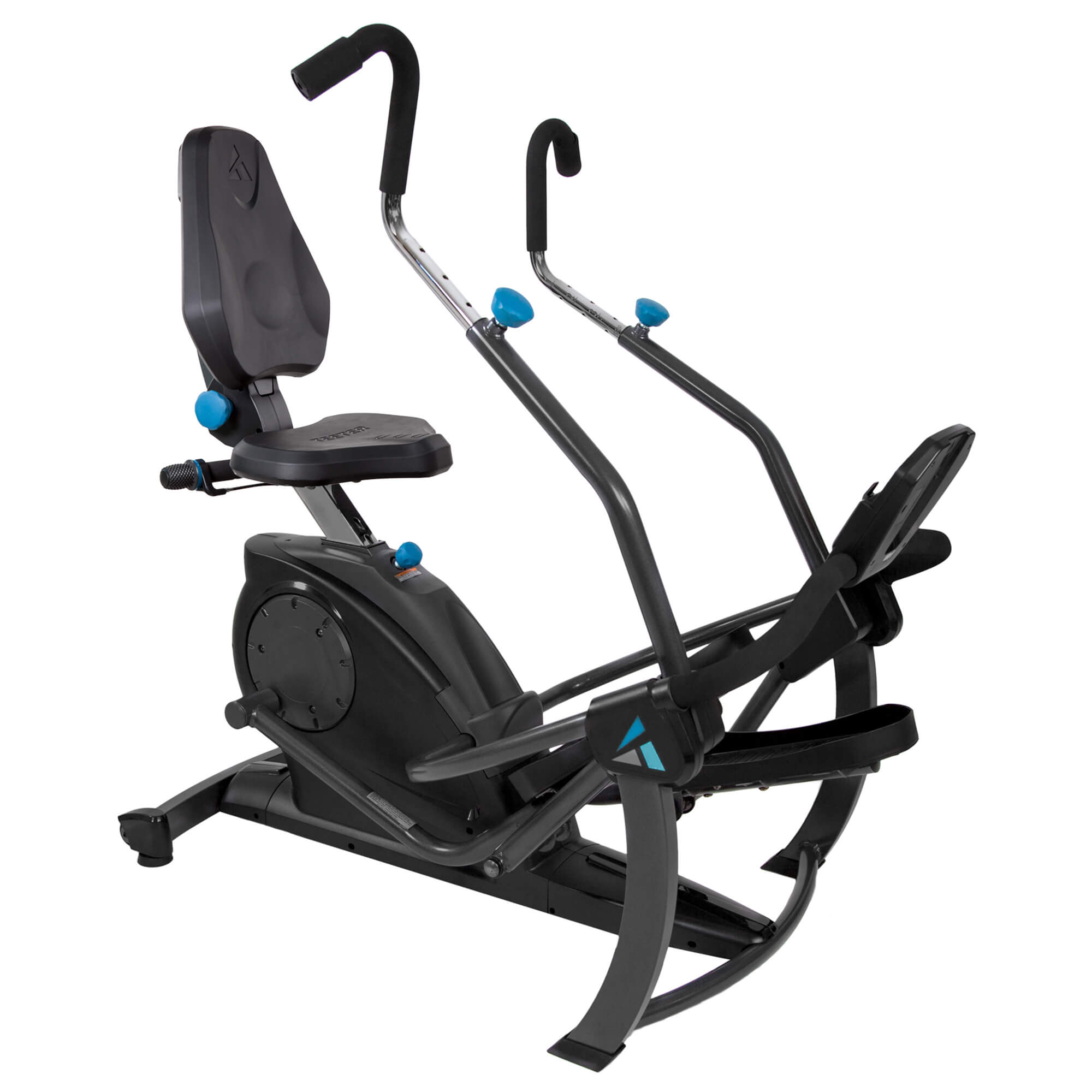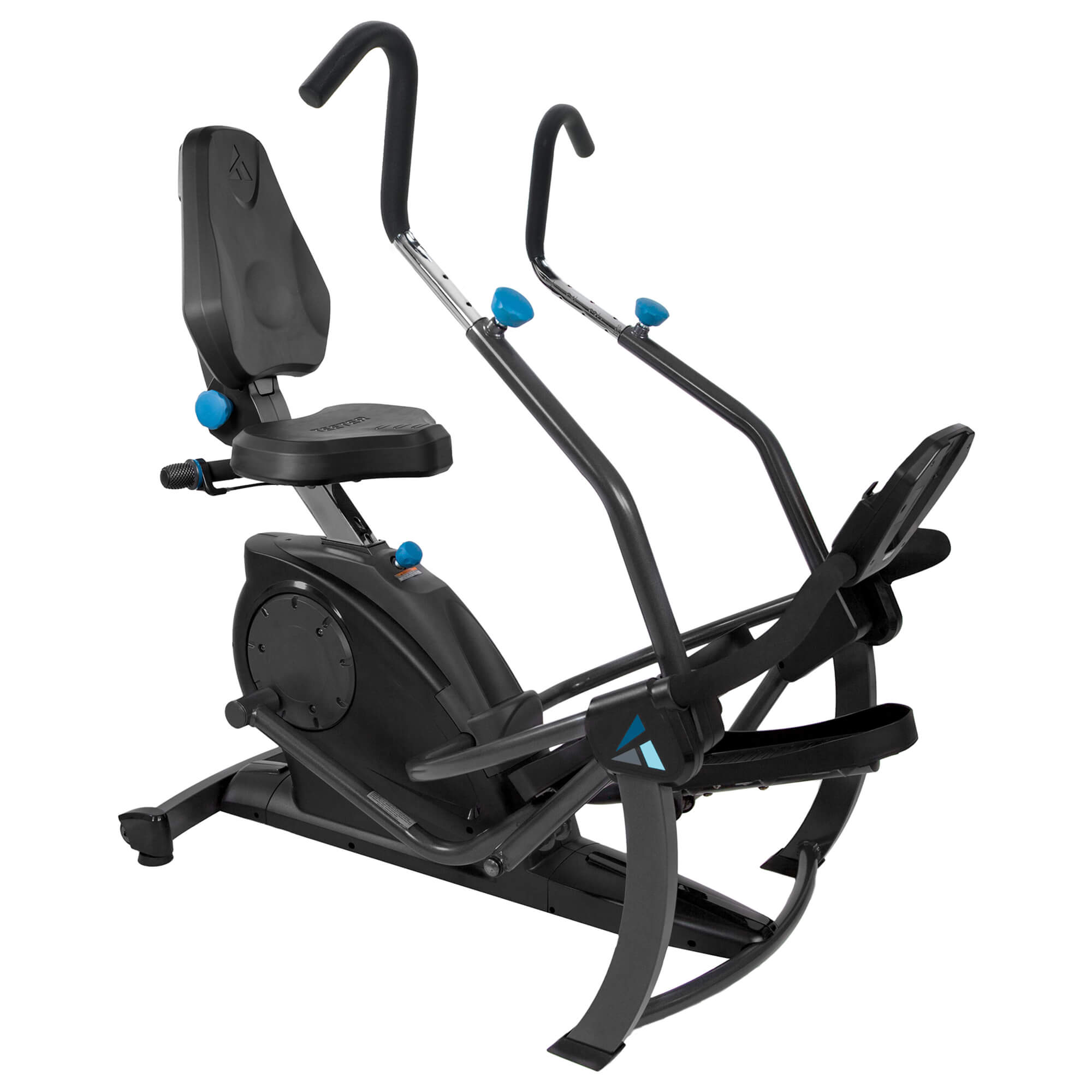When it comes to affordable recumbent cross trainers, Teeter and their FreeSteps are king, but with 2 such similar models to choose from, it can be hard to figure out which one makes more sense.
It’s true, the differences between the LT1 and the LT3 are very subtle, but there are a few differences worth knowing about.
Basically, the LT3 comes with a few comfort upgrades and a longer warranty, but both trainers perform pretty identically.
But are these subtle upgrades worth the extra cost?
Well, that’s what I’m here to help you figure out.
In this guide, I’ll go over all the key differences between Teeter’s FreeStep LT1 and LT3 – I’ll also provide my opinion (for whatever that’s worth) regarding which cross trainer I think is a better deal.
After reading, you’ll know which FreeStep is the better fit for your home.
Let’s roll.
| Teeter FreeStep LT1 | Teeter FreeStep LT3 | |
|---|---|---|
| Resistance | 15.4 lb flywheel 13 magnetic levels | 15.4 lb flywheel 13 magnetic levels |
| Frame | 107 lb assembled weight 300 lb weight limit | 110 lb assembled weight 300 lb weight limit |
| Warranty | 1 year all-inclusive | 2 year all-inclusive |
| Features | Simple LCD console Adjustable handles Adjustable angle backrest Standard pedals | Simple LCD console Upgraded rubber handles Larger, softer seat Adjustable backrest Rubber overlayed pedals Steel ball bearings |
| Price | ~$749 | ~$849 |
The Teeter FreeStep LT1 vs The LT3
The FreeStep LT1 and LT3 are both recumbent cross trainers.
These machines are similar to recumbent exercise bikes, but instead of pedaling in a circular motion, you press the pedals in a more linear movement – like a stepper.
This tends to put even less stress through the knees and hips, making recumbent cross trainers great options for people dealing with arthritis or achy joints.
And, like ellipticals, they come with moving handles that allow you to get your arms involved too.
Recumbent cross trainers are great, but they’re usually really expensive too – for example, you’re likely going to have to spend $4k+ to get your hands on the entry-level NuStep.
I wrote “usually” there because Teeter’s FreeSteps are one of the few exceptions to this rule.
With prices well under $1k, the LT1 and LT3 give folks significantly more affordable access to recumbent cross training.
These are the only cross trainers Teeters offers at the time of writing this, but they also have several inversion tables, strength training devices, and recovery tools to choose from as well.
Let’s start this comparison off by taking a look at each machine’s performance specs.
Performance
Even though we’re talking about recumbent cross trainers here, the LT1 and LT3 still operate a lot like recumbent bikes – so, I think it makes sense to check for the same performance specs.
This means checking out things like the flywheel weight, resistance levels, assembled weights, and weight capacities.
And just like with recumbent bikes, I think seeing higher numbers in all of these categories is always a good thing.
Having a heavier flywheel is beneficial because the extra weight builds more momentum as it spins, which in turn creates a smoother pedaling feel.
The LT1 and LT3 both come with the same 15.4 lb (7 kg) flywheel, so there’s no difference to speak of in terms of flywheel weight.
Both cross trainers also come with the same amount of magnetic resistance levels (13), so again, no differences there.
With the same flywheel and same amount of resistance levels, I think we can assume the LT1 and LT3 are capable of offering the same amount of resistance.
When we look at the frames of these 2 machines, we don’t see many differences either.
The LT1 and LT3 both have the same physical dimensions (55.25″ x 38″ x 52.5″) and there’s very little difference in assembled weight as well (107 lb vs 110 lb).
They both have the same 300 lb weight capacity and both models (according to Teeter) should be able to fit most folks between 4’11” and 6’6″ tall.
In other words, the LT1 and LT3 are the same size, the same weight, and come with the same resistance systems.
The only difference between the LT1 and LT3, in terms of performance, is that Teeter uses steel ball bearings where the leg crank meets the flywheel on the LT3 (vs plastic bushings on the LT1).
Technically, this could make the performance on the LT3 a little smoother, but I think the biggest benefit is that it likely increases the lifespan of that pivot.
I doubt most users will be able to tell much of a difference in terms of performance.
Overall though, the use of ball bearings on the LT3 is the only difference between the LT1 and LT3 when it comes to performance.
Features
So, let’s move right along and look at the features these cross trainers have to offer.
Both trainers come with the same, very simple console that tracks your time, distance, speed, and calorie expenditure during workouts.
Both also come with a little tablet holder where you can put your phone or tablet for easy viewing during use.
Both models come with adjustable angle backrests and height adjustable seats, as well as height adjustable handles (you can also rotate the handles on both to help target different upper body muscle groups).
Both FreeSteps also come with a water bottle holder, so no worries there.
The LT3 comes with a few little upgrades over the LT1 in terms of comfort though.
The LT3 comes with upgraded, rubber coated handles for improved durability over the standard foam handles found on the LT1 (also makes them a little easier to clean).
The LT3 also comes with a rubber overlay over the pedals, giving them a thicker, more tractiony (I’m pretty sure that’s not a real word) feel.
More noticeably, the LT3 comes with a larger, thicker seat than the LT1, which alone might be worth the extra cash for folks who have a hard time getting comfortable on exercise equipment.
Overall, the LT1 and LT3 are both pretty simple devices when it comes to their consoles, but the LT3 comes with a few upgrades over the LT1 when it comes to the handles, pedals, and seat.
Warranty
There’s a noticeable difference between the warranties offered on these 2 exercise machines too.
Teeter backs their FreeStep LT1 with the following warranty:
- 1 year all-inclusive
And they back their FreeStep LT3 with this warranty:
- 2 year all-inclusive
I know an extra year might not sound like much, but in this case, the LT3’s guarantee is 2x as long as the LT1’s – which I think is pretty significant.
One could argue that both warranties are kinda short, especially since there’s no separate frame guarantee, but realistically, the frame is the least likely thing to breakdown on these fitness machines.
So that means these guarantees are most applicable to the parts.
And a 2 year parts warranty is solid for this price range.
But I’m getting besides the point here – a big difference between these 2 FreeSteps is found in the warranty department, with Teeter backing the LT3 with an additional year of coverage.
Price
At the time of writing this, Teeter has their LT1 and LT3 listed for the following prices:
FreeStep LT1: $749
FreeStep LT3: $849
Now these prices can change at any time, so they might be a little different by the time you read this, but Teeter’s prices have been pretty stable, so I doubt they’ll change that much.
Regardless, the LT3 generally costs about $100 more than the LT1.
Which isn’t much, especially in the world of home fitness equipment.
But still, $100 is $100… is the LT3 worth the extra cash?
Final Thoughts
I would say yes.
Even though the LT1 and LT3 are identical when it comes to their performance specs, I think the added comfort features (when combined together) warranty the extra $100.
Especially the larger, softer seat.
But for me, I think the extended warranty alone is worth the extra hundred bucks.
And when you consider that the LT3 comes with the upgraded comfort features and the longer warranty, I think it’s a pretty easy decision to go all-in with the LT3.
But if you’re working with a tight budget and can’t make the LT3 work, I wouldn’t worry – again, there’s really no difference between these trainers when it comes to performance.
You can get a low-impact, comfortable cardio workout on either.
Overall, when it comes to affordable recumbent cross trainers, Teeter is easily one of the best brands in the game and their LT1 and LT3 both have a lot to offer for the respective prices.
But when push comes to shove, I think the LT3 is the better buy.








You explained exactly the question I was looking for an answer to; appreciate it. What I am wondering about-if this will work for me. I had polio and right leg was paralyzed. I wear a long leg brace on right leg. I used to have a stationary bike and had no problem with that. My right leg couldnt do much, went along for the ride mostly.
Yes, I think either Teeter FreeStep would work for you based on what you described. If you were able to comfortably use a stationary bike, you shouldn’t have any problems using a recumbent trainer. Recumbent trainers actually normally work a little better, since the pedal motion is a little more linear than stationary bikes (makes for a little lower-impact mode of exercise). This is why you see recumbent trainers in most rehab facilities. And your right leg should still be able to go along for the ride here. I hope that helps and thanks for reading!